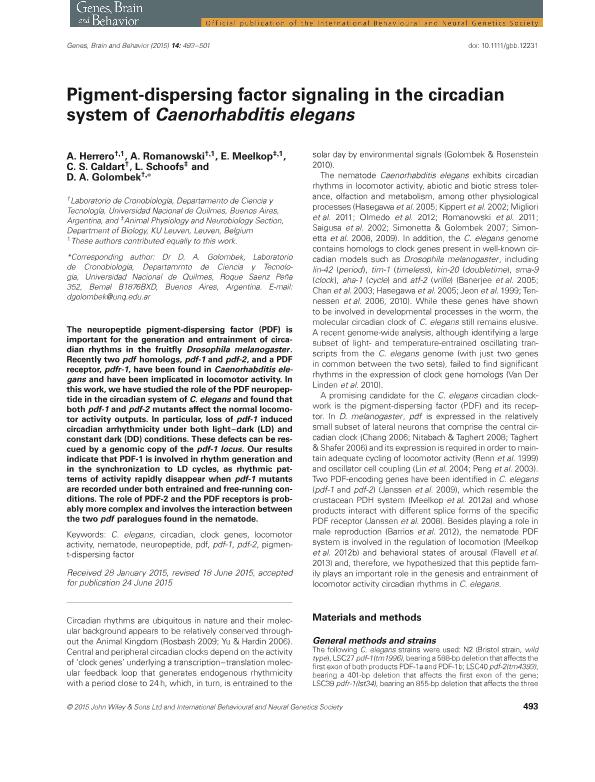Mostrar el registro sencillo del ítem
dc.contributor.author
Herrero, A.
dc.contributor.author
Romanowski, A.
dc.contributor.author
Meelkop, E.
dc.contributor.author
Caldart, C.s.
dc.contributor.author
Schoofs, L.
dc.contributor.author
Golombek, Diego Andres

dc.date.available
2017-06-12T21:10:25Z
dc.date.issued
2015-07
dc.identifier.citation
Herrero, A.; Romanowski, A.; Meelkop, E.; Caldart, C.s.; Schoofs, L.; et al.; Pigment-dispersing factor signaling in the circadian system of Caenorhabditis elegans; Wiley Blackwell Publishing, Inc; Genes, Brain and Behavior; 14; 6; 7-2015; 493-501
dc.identifier.issn
1601-1848
dc.identifier.uri
http://hdl.handle.net/11336/18044
dc.description.abstract
The neuropeptide pigment-dispersing factor (PDF) is important for the generation and entrainment of circadian rhythms in the fruitfly Drosophila melanogaster. Recently two pdf homologs, pdf-1 and pdf-2, and a PDF receptor, pdfr-1, have been found in Caenorhabditis elegans and have been implicated in locomotor activity. In this work, we have studied the role of the PDF neuropeptide in the circadian system of C. elegans and found that both pdf-1 and pdf-2 mutants affect the normal locomotor activity outputs. In particular, loss of pdf-1 induced circadian arrhythmicity under both light-dark (LD) and constant dark (DD) conditions. These defects can be rescued by a genomic copy of the pdf-1 locus. Our results indicate that PDF-1 is involved in rhythm generation and in the synchronization to LD cycles, as rhythmic patterns of activity rapidly disappear when pdf-1 mutants are recorded under both entrained and free-running conditions. The role of PDF-2 and the PDF receptors is probably more complex and involves the interaction between the two pdf paralogues found in the nematode.
dc.format
application/pdf
dc.language.iso
eng
dc.publisher
Wiley Blackwell Publishing, Inc

dc.rights
info:eu-repo/semantics/openAccess
dc.rights.uri
https://creativecommons.org/licenses/by-nc-sa/2.5/ar/
dc.subject
C. Elegans
dc.subject
Circadian
dc.subject
Clock Genes
dc.subject
Locomotor Activity
dc.subject
Nematode
dc.subject
Neuropeptide
dc.subject
Pdf
dc.subject
Pdf-1
dc.subject
Pdf-2
dc.subject
Pigment-Dispersing Factor
dc.subject.classification
Bioquímica y Biología Molecular

dc.subject.classification
Ciencias Biológicas

dc.subject.classification
CIENCIAS NATURALES Y EXACTAS

dc.title
Pigment-dispersing factor signaling in the circadian system of Caenorhabditis elegans
dc.type
info:eu-repo/semantics/article
dc.type
info:ar-repo/semantics/artículo
dc.type
info:eu-repo/semantics/publishedVersion
dc.date.updated
2017-06-12T20:03:31Z
dc.journal.volume
14
dc.journal.number
6
dc.journal.pagination
493-501
dc.journal.pais
Reino Unido

dc.description.fil
Fil: Herrero, A.. Universidad Nacional de Quilmes. Departamento de Ciencia y Tecnología. Laboratorio de Cronobiología; Argentina
dc.description.fil
Fil: Romanowski, A.. Universidad Nacional de Quilmes. Departamento de Ciencia y Tecnología. Laboratorio de Cronobiología; Argentina
dc.description.fil
Fil: Meelkop, E.. Katholikie Universiteit Leuven; Bélgica
dc.description.fil
Fil: Caldart, C.s.. Universidad Nacional de Quilmes. Departamento de Ciencia y Tecnología. Laboratorio de Cronobiología; Argentina
dc.description.fil
Fil: Schoofs, L.. Katholikie Universiteit Leuven; Bélgica
dc.description.fil
Fil: Golombek, Diego Andres. Universidad Nacional de Quilmes. Departamento de Ciencia y Tecnología. Laboratorio de Cronobiología; Argentina
dc.journal.title
Genes, Brain and Behavior

dc.relation.alternativeid
info:eu-repo/semantics/altIdentifier/doi/http://dx.doi.org/10.1111/gbb.12231
dc.relation.alternativeid
info:eu-repo/semantics/altIdentifier/url/https://www.ncbi.nlm.nih.gov/pubmed/26113231
Archivos asociados
